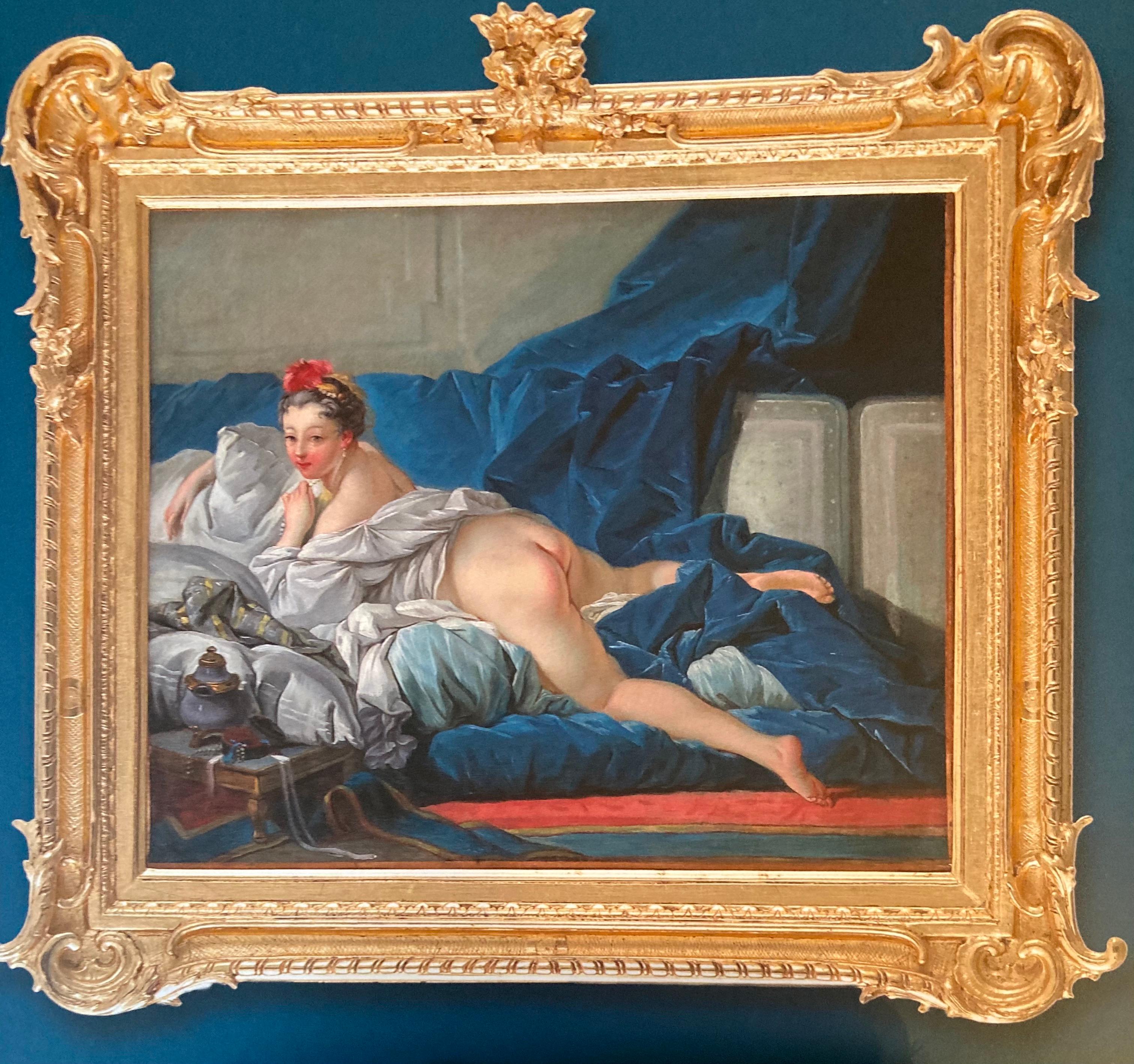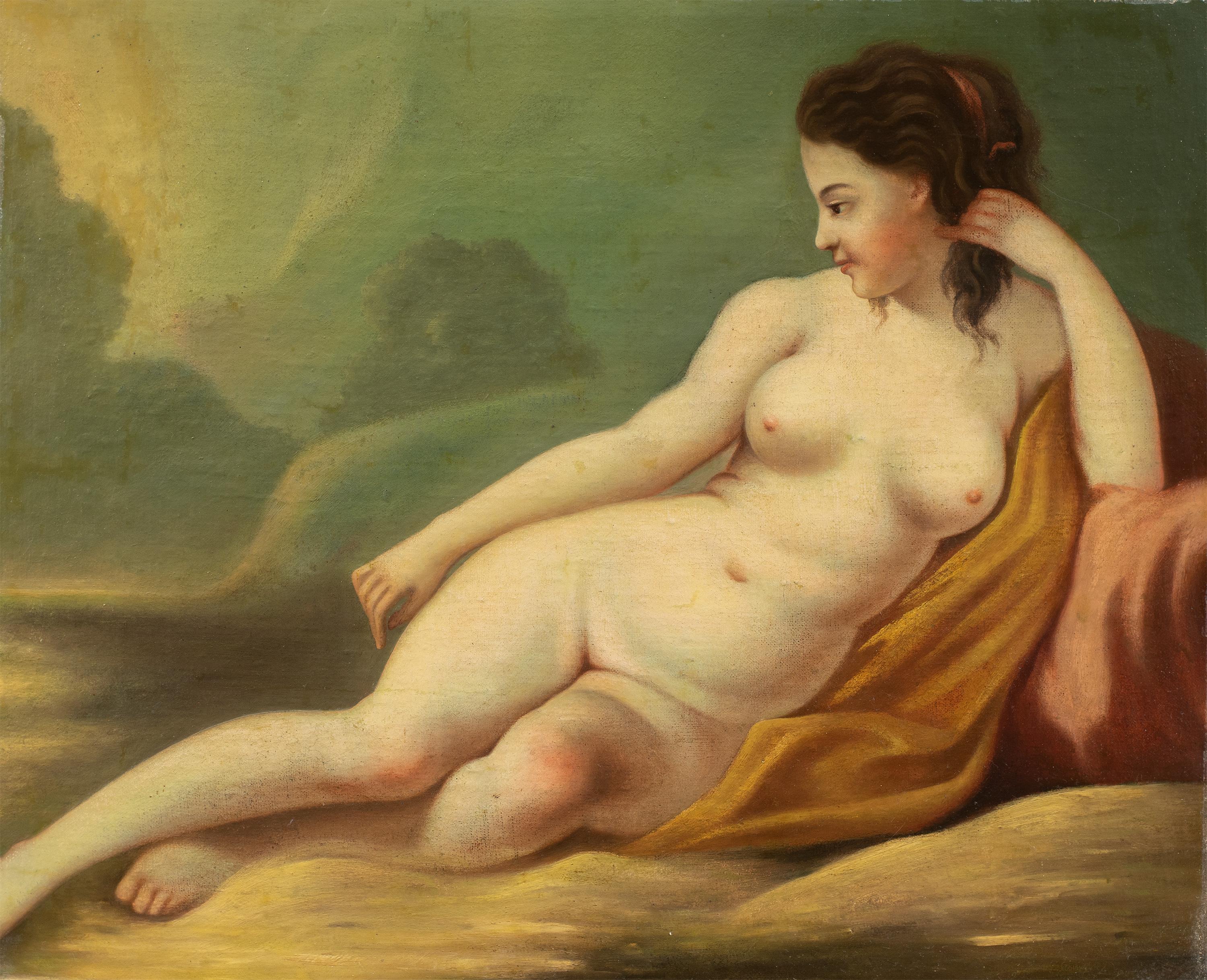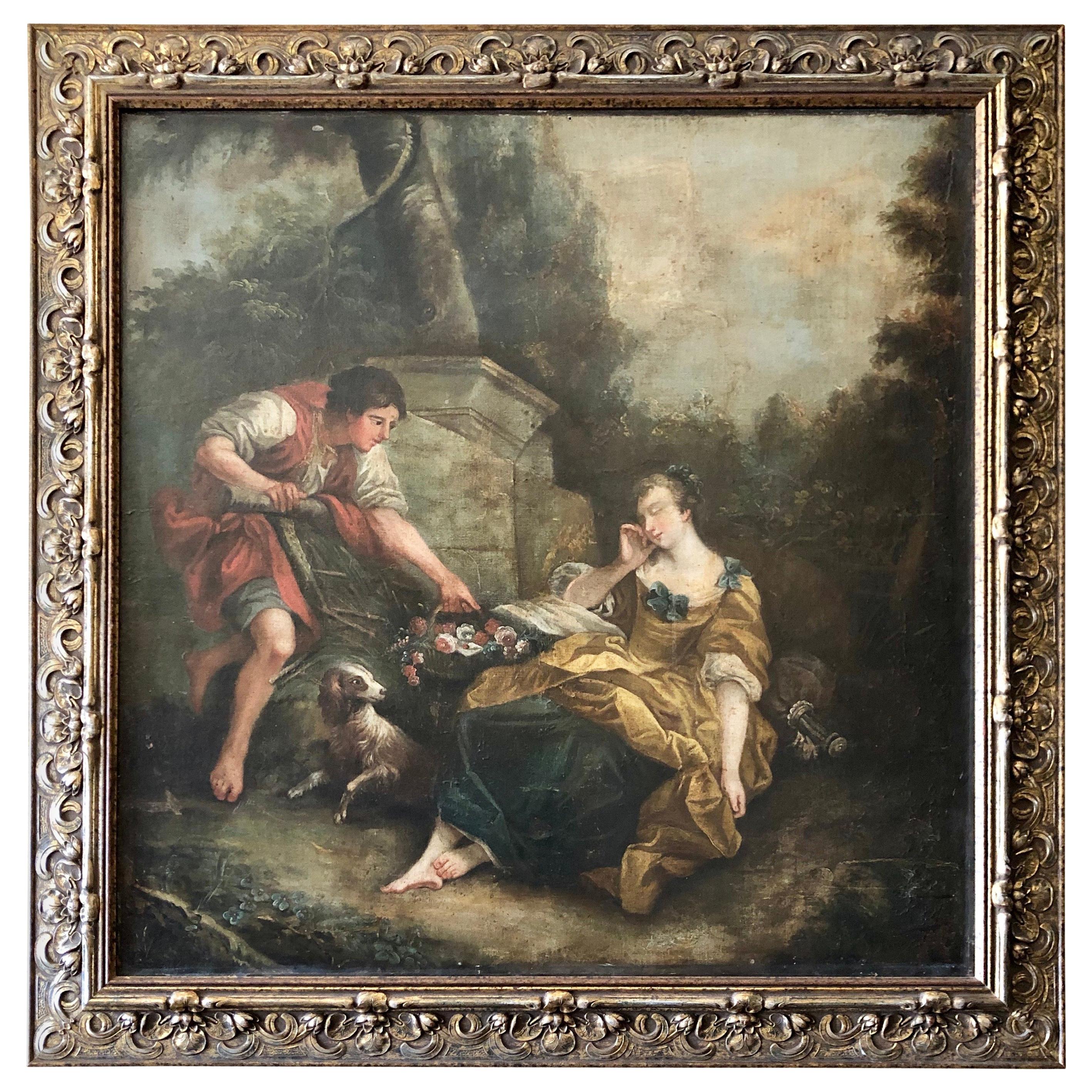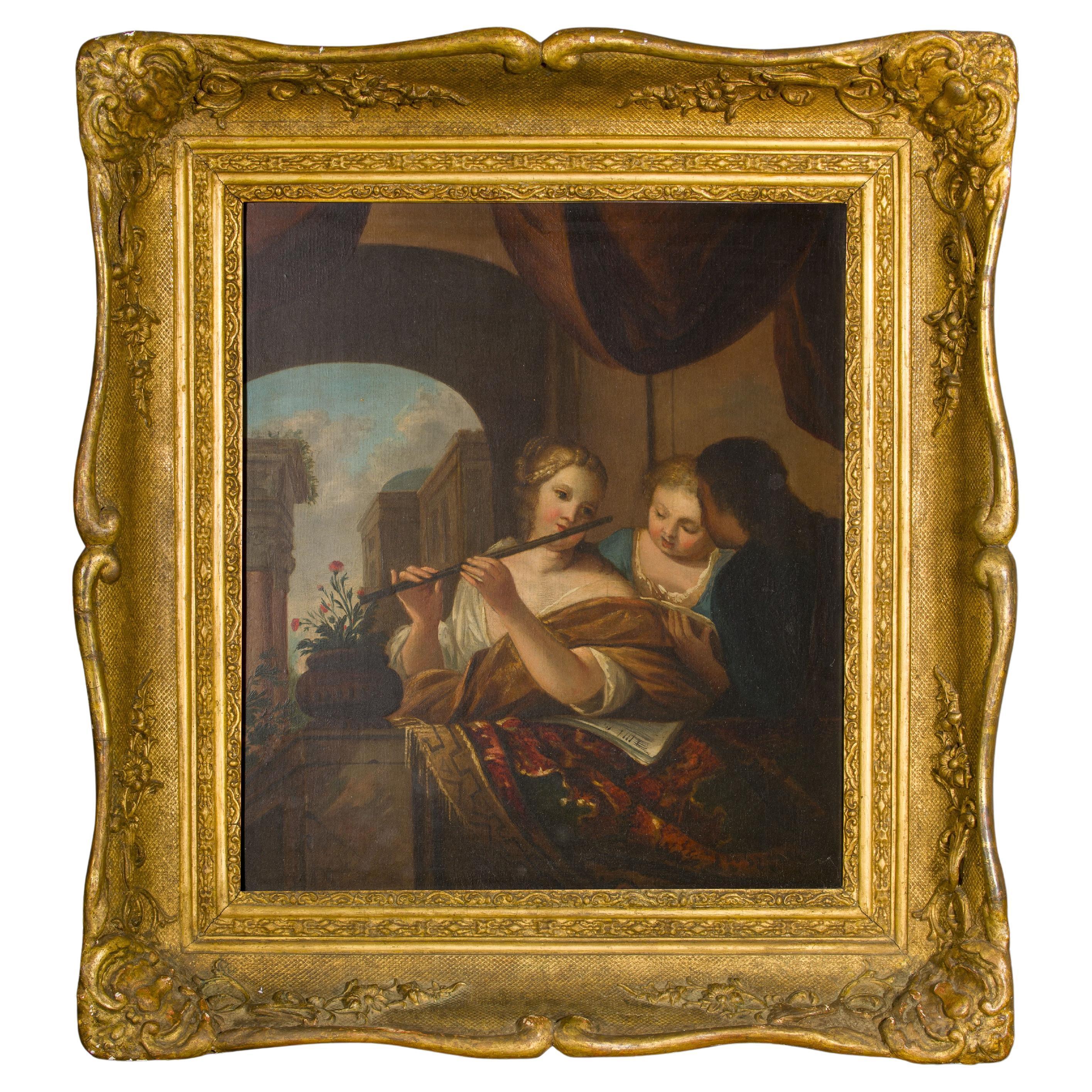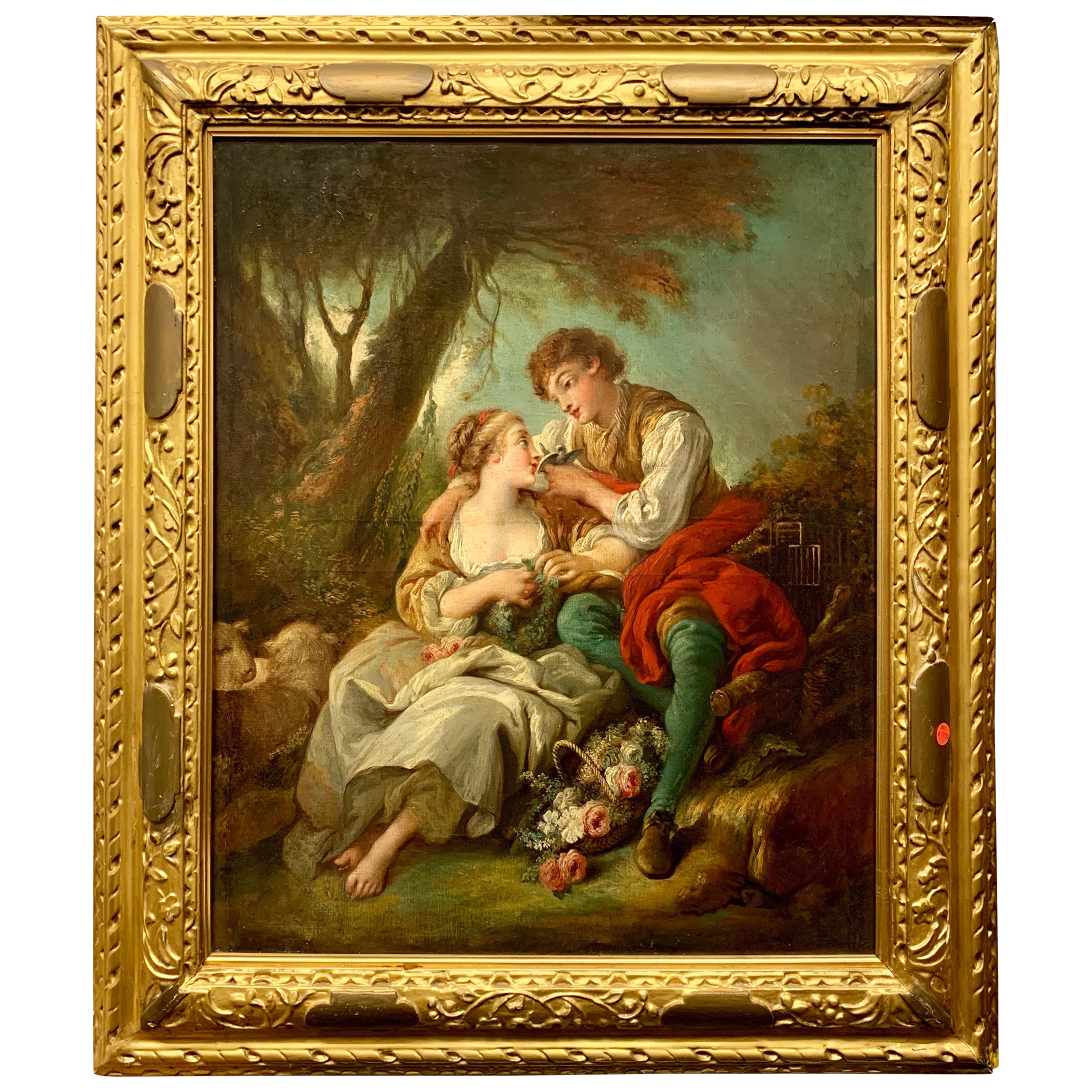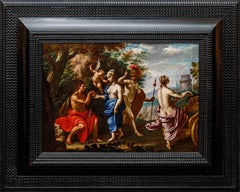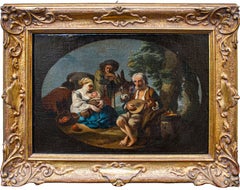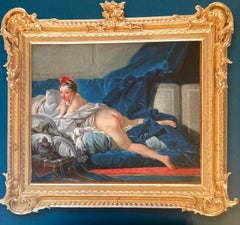Items Similar to After Francois Boucher, Odalisque
Want more images or videos?
Request additional images or videos from the seller
1 of 8
After Francois Boucher, Odalisque19th Century
19th Century
$8,608.63
£6,365.92
€7,200
CA$11,913.06
A$13,264.46
CHF 6,902.57
MX$160,099.50
NOK 86,564.55
SEK 81,765.67
DKK 54,828.39
About the Item
Second half of the 18th century, follower of François Boucher
Odalisque
Oil on canvas, 75 x 125 cm
Framed, 124 x 152 cm
In the 18th century, French artist François Boucher did not depict women as classically beautiful Venuses, but as muses with provocative, erotic, and unequivocal poses. A painter in the court of Louis XV and a favorite of the Marquise de Pompadour, François Boucher was both criticized and admired. Among the French master's most famous works is certainly The Odalisque: lying on her stomach and with her legs spread, the woman in Boucher's famous painting wears nothing but a delicate blue ribbon in her blond hair. Undaunted in her nudity, the woman rests on a chaise longue and her gaze is drawn to something outside the frame of the painting. The model in this celebrated painting would be Marie-Louise O'Murphy, a young daughter of Irish immigrants born in 1737 who worked as a seamstress in Paris. After meeting Boucher in 1751, Marie-Louise was hired by the artist as a model. She later became the mistress of Louis XV. Boucher created two versions of this scene: one at the Alte Pinakothek in Munich and the other at the Wallraf-Richartz Museum in Cologne.
In 1752, Boucher painted Marie-Louise again, copying his own work with some modifications. This time he chose a darker palette and added an oriental incense burner in the lower left corner instead of the open book. The artist responsible for our painting, certainly a follower of Boucher, combines different elements of the three versions of the Odalisque, resulting in an original composition that does not slavishly imitate the innovative models introduced by the master.
François Boucher was born in 1703 in Paris, the son of a draftsman with a passion for furniture and decorative arts. His artistic training was under the painter François Lemoyne, whose most notable works are the murals of the Château de Versailles. In 1723, Boucher received the Grand Prix de Rome from the Royal Academy of Painting and Sculpture. During his lifetime he spent four years studying in Italy, where he was inspired by the paintings of the late Renaissance Italian masters Titian, Tintoretto and Veronese. Upon his return to France, Boucher tackled all genres. He designed works for the Manufacture des Gobelins in Beauvais and the Manufacture de Porcelaine in Sèvres, was decorator of the Opera and later director of the Royal Academy. Boucher's mastery undoubtedly lay in his ability to paint human forms and precious fabrics such as silk. In 1742, Boucher was appointed Premier peintre du Roi. He also received special support from the Marquise de Pompadour, who posed for him on several occasions. François Boucher became the most sought-after painter of the mid-18th century. His works have caused a stir in the art world not only in France but throughout Europe.
François Boucher's nude paintings certainly did not go unnoticed by his contemporaries. In 1761, Denis Diderot commented on the painter's canvases with a mixture of admiration and disapproval: "What colors! What a variety! What a wealth of objects and ideas! This man has everything but the truth." Later, the Goncourt brothers would sum up Boucher's profile in these terms: "Elegant vulgarity, that is Boucher's signature. [...] To put it bluntly, and daring to use a slang term from the workshops that paints his talent somewhat harshly: he is a rogue." His success was accompanied by strong criticism, including that of the realist painter Millet, who discovered his paintings in Parisian museums: "I even had a very pronounced revulsion for Boucher. I could see his science, his talent, but I could not understand his provocative subjects and see his sad women, without thinking how poor in nature this was. Boucher does not make naked women, but little undressed creatures: they are not the shapely display of Titian's women, proud of their beauty to the point of flaunting it, to the point of showing themselves naked, so confident were they of their power."
- Creation Year:19th Century
- Dimensions:Height: 29.53 in (75 cm)Width: 49.22 in (125 cm)
- More Editions & Sizes:75x125Price: $8,609
- Medium:
- After:(After) Francois Boucher
- Period:
- Condition:
- Gallery Location:Milan, IT
- Reference Number:1stDibs: LU2639216356182
About the Seller
No Reviews Yet
Vetted Professional Seller
Every seller passes strict standards for authenticity and reliability
1stDibs seller since 2023
Typical response time: <1 hour
- ShippingRetrieving quote...Shipping from: Milan, Italy
- Return Policy
Authenticity Guarantee
In the unlikely event there’s an issue with an item’s authenticity, contact us within 1 year for a full refund. DetailsMoney-Back Guarantee
If your item is not as described, is damaged in transit, or does not arrive, contact us within 7 days for a full refund. Details24-Hour Cancellation
You have a 24-hour grace period in which to reconsider your purchase, with no questions asked.Vetted Professional Sellers
Our world-class sellers must adhere to strict standards for service and quality, maintaining the integrity of our listings.Price-Match Guarantee
If you find that a seller listed the same item for a lower price elsewhere, we’ll match it.Trusted Global Delivery
Our best-in-class carrier network provides specialized shipping options worldwide, including custom delivery.More From This Seller
View AllGirolamo Maria Pesci (Rome, 1679 - 1759), The judgment of Paris
Located in Milan, IT
Girolamo Maria Pesci (Rome, 1679 - 1759)
The judgment of Paris
c. 1705-1710
Oil on canvas, 47 x 36.5 cm
Girolamo Maria Pesci (Rome, 1679 - 1759), a figure distinguished for his e...
Category
18th Century and Earlier Other Art Style Figurative Paintings
Materials
Canvas, Oil
After Peter Paul Rubens, Allegory of Abundance
By (After) Peter Paul Rubens
Located in Milan, IT
Rubensian school, 17th century
Allegory of abundance
Oil on panel, 30.5 x 45 cm
With frame 38.5 x 55 cm
Category
17th Century Other Art Style Figurative Paintings
Materials
Canvas, Oil
Paolo Monaldi (Rome, 1710 - after 1779), attr. , Genre scene
Located in Milan, IT
Paolo Monaldi (Rome, 1710 - after 1779), attr.
Genre scene
Oil on canvas, 28 x 38 cm
Framed, 36.5 x 46 cm
The canvas depicts a moment of repose drawn from the rural world: the...
Category
18th Century and Earlier Other Art Style Figurative Paintings
Materials
Canvas, Oil
Francesca Volò Smiller, known as Francesca Vincenzina, Still Life
Located in Milan, IT
Francesca Volò Smiller, known as Francesca Vincenzina (Milan, 1657-1700)
Still life with flowers, vegetables, bunches of grapes and putti
Oil on canvas, 102x150 cm
Oral communicat...
Category
17th Century Other Art Style Figurative Paintings
Materials
Canvas, Oil
From Paolo Veronese, Allegory of Strength and Wisdom
By Paolo Veronese
Located in Milan, IT
Follower of Paolo Veronese (Verona, 1528 - Venice, 1588)
Allegory of wisdom and strength
Oil on canvas, 48 x 36.5 cm
Picture frame, 61 x 48 cm
The Allegory of Wisdom and Strength...
Category
16th Century Other Art Style Figurative Paintings
Materials
Canvas, Oil
pietro Antonio Rotari's circle, girl with flower basket
Located in Milan, IT
18th century, circle of Pietro Antonio Rotari (Verona, Sept. 30, 1707 - St. Petersburg, Aug. 31, 1762)
Girl with flower basket
Oil on canvas, 52 x 70 cm
Framed, 62 x 80 cm
Unsig...
Category
18th Century Other Art Style Portrait Paintings
Materials
Canvas, Oil
You May Also Like
Rococo Painting, The Brunette Odalisque, Nude Woman, Studio of Francois Boucher
By François Boucher
Located in Greven, DE
A voluptuous woman lies prone on a divan, bearing her backside and turning her head flirtatiously to the viewer, though averting her eyes slightly, as if to maintain a coy demeanor. Surrounded by lush fabrics of deep blues, the creamy tones of her skin and dressing gown are thrown in sharp contrast, making the figure glow luminously. The whole painting is ordered by folds - of flesh, of fabric, of cushions, of the rug - inviting the viewer's eye to look closely across the topography of the canvas.
One of Boucher's cabinet paintings (that is, paintings made for private collectors rather than official exhibition at the Salon), the open eroticism of this work invites a voyeuristic gaze. Although it was created for a private audience, it was later displayed at the Salon of 1767, where the critic Denis Diderot found it shocking and lascivious. Nonetheless, Boucher would later paint another iteration of this reclining pose, this time using Marie-Louise O'Murphy, a favorite mistress of King Louis XV, as his model, suggesting that the provocative composition was a stock figure for Boucher's private commissions.
"The Brunette Odalisque" (French: L'Odalisque or l'Odalisque brune) is a painting of c. 1745 by François Boucher, now in the Louvre in Paris. He later produced two other works in the odalisque genre, both known as "The Blonde Odalisque".
The present painting is another version of Bouchers painting which differs in minor details. The quality of the paint is very fine and the whole technique and style allows a dating to c. 1750. As Boucher's Painting was very famous there were several copies and versions which were made by his studio. The present painting can be attributed to the close circle of Boucher.
The Painting is framed in a golden frame which was built in the Rococo style in c. 1990.
Both the title of Boucher's painting and the objects found in the interior fix the subject as an odalisque, a concubine within the harem of the Ottoman sultan. The sumptuous textiles and exotic, decorative objects suggest early traces of Orientalism, although the figure appears European. Odalisque paintings...
Category
18th Century Rococo Nude Paintings
Materials
Canvas, Oil
After Francois Boucher - Mid 20th Century Oil, La Marotte
Located in Corsham, GB
A naive copy of Francois Boucher (1703-1770) romantic oil, 'La Marotte'. Illegibly inscribed to the lower right. On canvas on stretchers.
Category
20th Century Figurative Paintings
Materials
Oil
$296 Sale Price
20% Off
Rococò Italian painter - 18th/19th century figure painting - Nude female
Located in Varmo, IT
Italian painter (18th-19th century) - Female nude.
44 x 54 cm without frame, 54 x 64 cm with frame.
Antique oil painting on canvas mounted on a panel, in a carved and gilded wooden...
Category
Late 18th Century Rococo Figurative Paintings
Materials
Canvas, Oil
$1,793 Sale Price
40% Off
Free Shipping
Oil Painting in the Style of Francois Boucher
Located in Dallas, TX
This oil painting in the style of Francois Boucher origins from France, circa 1860.
Category
Antique 19th Century French Paintings
Materials
Paint
18th Century French Rococò Painting
By Jean Raoux
Located in Roma, IT
18th Century French Rococò Painting
An oil on panel painting attributed to the great French artist of the eighth century, Jean Ra...
Category
Early 18th Century Rococo Portrait Paintings
Materials
Wood, Canvas, Oil
19th Century Oil Painting on Canvas after Francois Boucher
Located in Los Angeles, CA
This magnificent painting dates to the 19th century after the original by Francois Boucher.
François Boucher was a French painter, draughtsman and et...
Category
Antique 19th Century European Paintings
Materials
Canvas
More Ways To Browse
Boucher Painting
Marie Versailles
Gobelin Antique
Oil Painting Murphy
Gobelin Framed
Diderot Denis
Antique Murphy
Antique Tanto
Luis Xv
Maeght Lithograph
18th Century Architectural Engravings
Antique Bourbon
1960s Pop Art
Lithograph Prints Of Architecture
Rolling Stone Magazine
Picasso Color Lithograph
Vintage Western Art Prints
Transformation Sculpture
